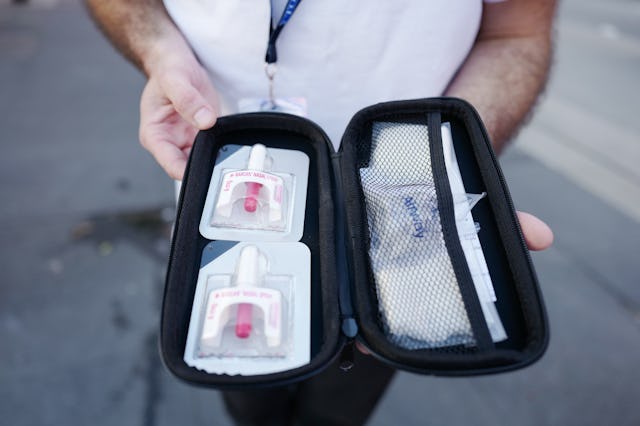Experts Say Parents Should Keep This Surprising Item In Their First Aid Kits
You may never need it, but if you do, you’ll be so glad it was on hand.

Band-Aids, antibiotic ointment, tweezers — most parents have at least a basic first aid kit in their home, or the supplies you’d find in one anyway, even if they’re not stored all together in a little box with a red cross on it. But what you likely don’t have is naloxone (you might know it by one of its brand names, Narcan). While it may surprise you to hear, experts on drug safety highly recommend parents keep naloxone in their homes, regardless of their children’s ages.
Naloxone is a medication that blocks the opioid receptors in the brain; it’s most commonly available in the form of a nasal spray, though injections exist, too. Its purpose: reversing an overdose, either from opioids or synthetic opioids, like fentanyl. You can purchase it over the counter for roughly $30 for two doses, depending on the retailer. But if you’re not in a family with anyone who uses opioids, why on earth would you need it?
“Naloxone should be kept in homes to protect our kids, our families, and our loved ones from accidental opioid exposure. Do you have a fire extinguisher in your home somewhere? Yeah, because we live in a world where there could be a fire. I have electrical socket covers because I live in a world where my toddler puts his fingers into the electrical sockets. When we live in a world with opioids and homes that have opioids in them, it just makes common sense in my mind to have Naloxone on hand,” says Rachael Duncan, PharmD, mother of two and associate director of The Naloxone Project.
While opioid exposures in kids under 18 are hard to track in the U.S., Duncan says accidental poisonings are the number two preventable cause of death for children under age 5. Opioids are the primary cause of those — Duncan describes them as “uniquely lethal.” “We know that over half of these [incidents] happen in the home. For toddlers, almost all of them are happening in the home. For teenagers, about half are happening in the home. Another percentage are happening at a friend’s home and then out in the public, of course, because teenagers are out and about.”
Overdoses can happen quickly and cause the victim to vomit, turn blue in the lips and fingertips, and become unable to speak or unresponsive. Scariest of all, their breathing may become irregular or stop completely. If that happens to your child, you’ll want a way to reverse it immediately.
“I’d like to be prepared in case my kid ever ends up trying drugs. Also, I had surgery a couple of years ago and had a few opioid painkillers in my house. My spouse has also had surgery a couple of times. All of us should lock our pills up and put them where our kids can’t find them, but accidents happen,” says Mike Selick, MSW, director of capacity building and community mobilization at the National Harm Reduction Coalition (and a parent). “You locked up all your pills, but you had a couple of them in the pill organizer by your bed for when you woke up and the kid found it, or maybe it fell out under the bed. They put it in their mouth. The last thing I want to do is not have the easy solution that can save my kid’s life at that exact moment.”
Parents don’t like to think about it, but older children’s exposures may not be accidental. They may decide to try drugs, and either intentionally take opioids or accidentally take something laced. Both Duncan and Selick pointed out that there is zero harm in using naloxone. If you find your child unresponsive and use it, it will either reverse an overdose or...do absolutely nothing. It would be like squirting saline up the nose, Duncan says. Essentially, there’s no harm in using it, but the potential for harm is if you don’t have it.
What kind of naloxone should parents get?
You can buy naloxone over-the-counter from pharmacies and on Amazon. They usually come in sets of two, so you can keep one in your home or car and give one to your teen. Parents should look for products that contain 3 or 4 milligrams of naloxone, Selick recommends. Some brands contain up to 8 milligrams, but he’d steer clear of those. Duncan says a 4 milligram dose is safe for everyone, from babies to senior citizens and even pets.
If you don’t have $30 to spend on naloxone, Google how to get naloxone for free in your state, Selick says. “Lots of places do give it out for free at this point, but you may find herself having to go to a drug treatment program, a syringe program, or a health department to get it there.” You can also visit getnaloxonenow.org for more tips on finding naloxone for free, and trainings on using it once you have it.
If you have insurance, they may cover it for you, Duncan says. Talk to your primary care provider or your child’s pediatrician about writing you a prescription. “Most insurances, especially Medicaid formularies in states, all cover this at a zero-dollar copay,” she says.
Finally, if you believe your child or someone you come across has overdosed, you should call 911 immediately, these experts say. Put them on speaker while administering the naloxone, and then begin rescue breathing (this is covered in the getnaloxonenow.org training Selick mentioned) while waiting for the medication to take effect.
While the subject of your child taking opioids is precisely zero fun to think about, these experts say it matters that we do. Not all risks have such an easy fix, but keeping naloxone in your home is a simple way to protect your kids.